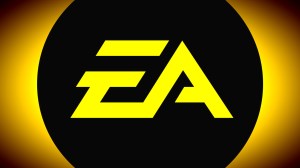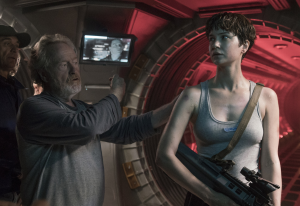The creative team behind the critically-acclaimed C.O.W.L. — writers Kyle Higgins and Alec Siegel with artist Rod Reis and letterer Troy Peteri — have reassembled to launch Hadrian’s Wall, a new “interstellar noir” that starts tomorrow from Image Comics.
Videos by ComicBook.com
The series centers on a man who is called in to rubber-stamp a murder on a spaceship…before realizing there’s far more to the case than meets the eye.
Higgins joined ComicBook.com to talk about the series. You can get a copy today at your local comic shop, or on ComiXology.

How many ideas do you go through before you land on something like Hadrian’s Wall?
Not very many, to be totally honest. In some ways, I feel like ideas are worthless. What I mean by that is whether a story is compelling or works or not comes down to how you explore an idea, and what you ultimately are saying with the idea, but also with the story itself.
I know a lot of people that have great ideas, but are never going to execute them. To be honest, that’s something I struggle with, too. I think every writer probably does.
A lot of time, the high concept stuff is not stuff that just kind of comes to me — it’s stuff I do have to sit down, go, “Okay, well, like let me take a notebook, and let me just kind of riff for a few minutes, and just kind of figure out like what I’m reading lately, what I’ve watching, if there’s a spark of something.” Usually, when something hits, I know immediately if it has legs or not because I can see what the kind of emotional core of it is, or can be.
With something like Hadrian’s Wall, actually, the concept of a murder-mystery on a spaceship is something that I’ve had for a long time, but didn’t have a story for. When we were wrapping up C.O.W.L., we all knew we wanted to keep working together, and we wanted to do something different, genre-wise, but also still something that could be really, really exciting to see Rod visually world-building.
That concept kind of pops back out to me, and so it turned into, “Okay, well if we’re going to do something that’s kind of like a 1980s-inspired sci-fi noir, what were kind of relevant issues in that era that I could map into the future?”
I’m a big Cold War guy, as well, so the Cold War elements and the frosty relationship between Earth and the Soviet Union…
…Frosty is, I’m oversimplifying, there. That was a dynamic that was really interesting to me. Then it turned into, “Okay, so how do I explore that in a real human way?” The idea of Simon, our main investigator, navigating his failed marriage, that’s where it clicked. That paralleling this relationship between, in our story, Earth and their biggest colony on Theta, was the core that really made the idea more than an idea. It started to turn it into a story.
There’s an element of a common noir trope here: “Yeah, this guy is very much in that mold of the guy who’s super, super good at his job, and part of that is letting everything else fall away.” How do you explore a trope like that and keep it fresh, and not feel like you’re retreading ground that somebody else has already done?
Again, it comes down to what your take on the trope is, and making sure that your story is centered and focused on the people in it. I don’t think … Tropes inherently aren’t bad, they’re just bad when they’re executed poorly, right?
So, I think that’s just something that Alec and I really push ourselves on, just trying to make sure that we’re being innovative, and taking an idea and spinning it on its head, and really kind of kicking the tires on everything that we put together, and making sure that every decision we’re making on a storytelling level is the best story decision that gets us the most mileage, and the most interesting emotional connection. So that does require a lot of obsessive, compulsive, kicking the tires on things.
I tend to be a very type-A writer, and I think one of the reasons Alec and I work so well together is that he can put up with me. It’s never personal. Everything we do is in service of the narrative, and making sure that we’re telling something that has resonance, and connects on an emotional level. I think as long as you stay centered and focused on that, the tropes don’t really matter. They start to fall away because you’re actually using these characters and these situations to say something.
You mentioned getting the band back together. It hadn’t occurred to me that Troy was lettering on C.O.W.L., as well. On C.O.W.L., he had a distinct look, but it didn’t feel nearly as stylized as this. In Hadrian’s Wall , the lettering feels like part of the kind of manic energy of the world. Is that something that you guys talked about with him, or is that just kind of what it came to?
That’s 100% something we talked about, but also something that he brought to us. We’ve done a lot of interviews for Hadrian’s Wall , and also for C.O.W.L., and to be totally frank, we don’t talk about Troy enough because what he brings to the table is that innovative spirit that we’re talking about right now, where he doesn’t like settling for generic. He does not like house styles, and he is constantly looking for ways to be innovative in the lettering that feel tonally consistent with what the book is trying to be.
What I mean by that, is Hadrian’s Wall , on an aesthetic level, is our love letter to ’70s and ’80s sci-fi movies: Alien, Aliens, Outland, Blade Runner.
From a comic standpoint, Rod is also pulling from ’80s comics. He’s heavily influenced by Moebius and different European artists of that era. Troy took one look at the art and the premise and said, “This should look like the new issue of Heavy Metal.” He just felt like that was the aesthetic that would help convey that tone, even on a subconscious level, that tone and that feel that we’re going for that makes the book hopefully unique. I think he knocked it out of the park.
The lettering is definitely stylized, but I think especially in a book where there’s so much talking, and you’re constantly running the risk in any sort of investigative comic of it becoming pages of talking heads. Anything you can do to make it feel different and visually engaging is super, super important. Both Rod and Troy bring that in spades.
One of the things that I always tell people, this is a weird kind of fascination of mine, is that if your colors and your letters look good, then you are like 95% more likely to have my attention because bad lettering just looks wildly unprofessional.
That’s not a weird fascination at all. That’s the advice I give. Every single panel I do about breaking into comics, or doing your own books, things like that, putting together ashcans, the number one thing I say is, “Hire a professional letterer.” It costs you $15 a page. Maybe you can get someone even cheaper to do it as a favor, take a shot on a short story, and do it, but it is so underappreciated. But when I open a book, the first thing I notice is the coloring, and the second thing I notice is the lettering.
So I always follow that statement up with, “Hire a professional colorist.” People don’t realize it, but you don’t actually notice the art in a book. That’s not the first thing your eye notices. Your eye notices the colors, and they set the mood, and they set the tone, and it might only be a half a second later that you start seeing the line art, but I do believe that the coloring comes first. The lettering is right there with it.
I think that’s doubly true on a book like Hadrian’s Wall because you are crafting a totally new world and a totally new look.
Yeah. I mean, we’re trying to do something that’s unique. For all of the kind of genre elements that you and I are talking about right now, I would say we are very, very focused on separating ourselves individually in the marketplace. It’s a very crowded marketplace, and the onus is on us as creators to push ourselves to innovate, and to do something different. Everyone on this book really prides themselves on that.
I haven’t really talked to you about what’s your elevator pitch for the book. When you’re trying to tell somebody at a convention, “Hey, pick this up,” what is it?
It’s an interstellar noir. It’s a murder mystery on a spaceship that follows investigator Simon Moore as he heads out to the far reaches of space to look into the death of an astronaut. Simon originally takes the case out of a sense of schadenfreude, to make money off of the death of this guy that he didn’t like. There’s a history there, and we realize very quickly it’s because this astronaut married Simon’s ex-wife.
Once Simon gets out to the ship, it becomes clear that there’s more going on here than meets the eye, and this is not just a rubber-stamp job. So in addition to figuring out who killed Edward Madigan, Simon will also be navigating his own failed marriage.
The backdrop to all this is this Cold War between Earth and its biggest colony on Theta. So ultimately, the book is this exploration of broken relationships. What tears people apart. What it takes to put them back together. Drugs, murder, corruption, and the PI with the sordid past.
What drives Moore to overcome his desire to just be like, “F–k that guy,” and to do the right thing even though it would be so easy not to?
Well I think as people will realize as they get deeper into the book, and start to learn about Simon’s history, and about the events that happened between Simon, Annabelle, and Edward, you’ll start to understand the level of guilt that Simon may be operating with. We establish very early on in #1 that the reason for all of the painkillers that Simon takes and is addicted to, is because Edward shot him four times, and then married Simon’s ex-wife.
That situation is a bit more complicated than it’s necessarily presented as in the first issue, so diving into that as the series goes on, I think we’ll start to shore up what it is about Edward that Simon can’t let go of.
The other aspect, too, I don’t want to say definitively, but Annabelle, Simon’s ex-wife, has a very interesting theory in #1 about why Simon’s out there, and as it relates to her and possibly the idea that Simon just can’t let go. I think that there’s definitely some merit to that. Whether Simon can admit that, or even recognize that himself is something that readers will have to pick up the series to find out about.
Let me just say one last thing, real quick: Rod Reis is a superstar artist in the making. I truly believe that, and the work that he did on C.O.W.L., as great as it was, Hadrian’s Wall is that much better. One of the things that-
The thing that excites me and Alec more than anything with Hadrian’s Wall is that it’s a showcase for Rod, and that people will get just how good he is, and what he can do when he cuts loose.








